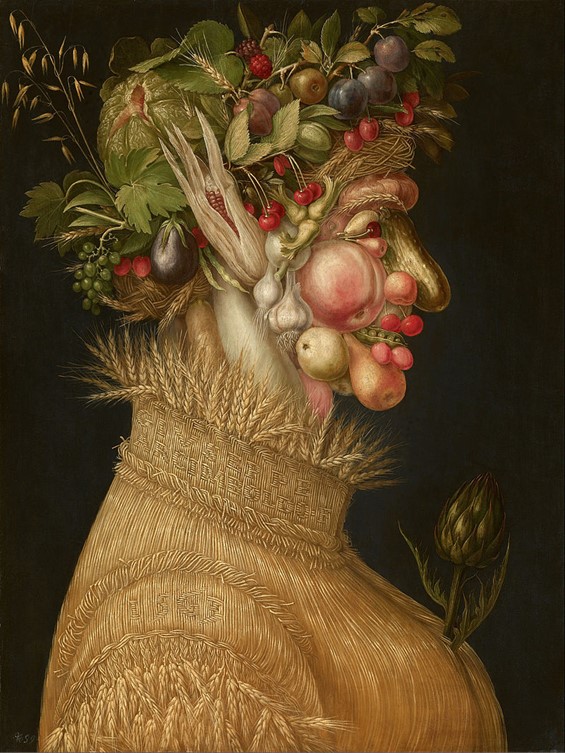
The Four Seasons – Summer, 1563, oil on panel, 670×508 mm, Kunsthistorisches Museum, Vienna, Austria
https://commons.wikimedia.org/wiki/File:Giuseppe_Arcimboldo_-_Summer_-_Google_Art_Project.jpg
Beneath the blazing sun’s relentless heat / men and flocks are sweltering, / pines are scorched. / We hear the cuckoo’s voice; then sweet songs of the turtle dove and finch are heard. / Soft breezes stir the air….but threatening north wind sweeps them suddenly aside. The shepherd trembles, fearful of violent storm and what may lie ahead. / His limbs are now awakened from their repose by fear of lightning’s flash and thunder’s roar, as gnats and flies buzz furiously around. / Alas, his worst fears were justified, as the heavens roar and great hailstones beat down upon the proudly standing corn. This is Antonio Lucio Vivaldi’s (1678 – 1741) Sonnet of L’Estate (Summer). The great composer wrote it as a descriptive accompaniment, experts believe, for the music of his “Four Seasons.” Today the first day of Summer, I took the time to listen, read and look at Summer by Giuseppe Arcimboldo! It was a magical time! https://www.charlottesymphony.org/blog/vivaldis-four-seasons-poems/
Giuseppe Arcimboldo was a very popular artist among royalty and wealthy patrons of 16th-century Europe. He became the official artist and Master of Festivals for three successive German Emperors. He was also in charge of creating costumes, stage settings, chariots, creative waterworks, and other diversions for courtly events and ceremonies. Last but not least, he directed the acquisitions for the royal cabinet of curiosities, which included art, antiques, curios, oddities of nature, and exotic animals and birds. https://www.denverartmuseum.org/en/edu/object/summer
Four hundred years later, Giuseppe Arcimboldo, is considered the great master of Renaissance allegorical painting. He is celebrated for using flowers, fruits, and vegetables, associated with the Seasons of the year, to create paintings of whimsical “composite heads,” and thus, he acquired international fame and fortune! For Emperor Maximilian II, for example, he painted in 1563, his signature Portraits of the 4 Seasons, exhibited today in Vienna, Paris, and Madrid. The 1563 set of four “composite” Portraits of the Seasons became so popular, that the artist replicated them multiple times over the course of his life. The originals, gifted to Maximilian II, were the plainest and most unadorned of all sets he later created.
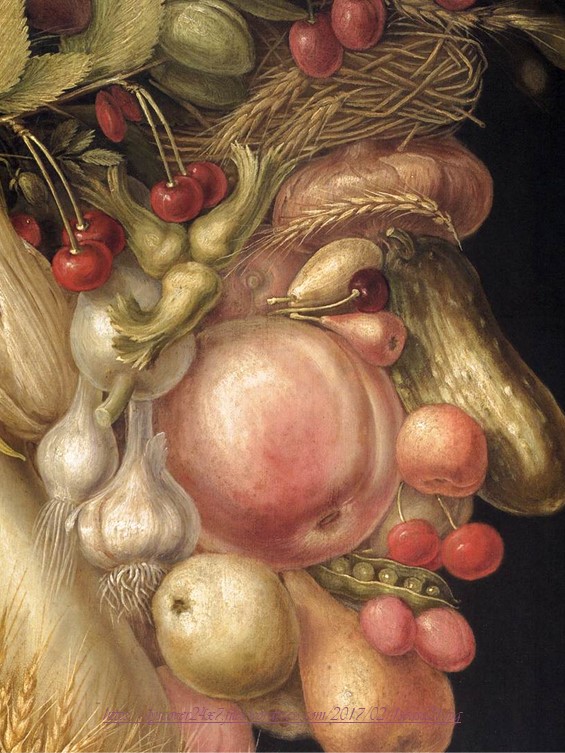
The Four Seasons – Summer (detail), 1563, oil on panel, 670×508 mm, Kunsthistorisches Museum, Vienna, Austria
https://dyscover24x7.files.wordpress.com/2017/02/1seaso21.jpg
Archiboldo’s 1563 Portrait of Summer is the perfect example to celebrate the beginning of the Summer season. Interestingly, it is on “Summer” that Arcimboldo chooses to sign his name for the series, carefully woven into her gown. Hidden in the dress’s collar is “Giuseppe Arcimboldi • F,” where the F stands for “Fecit” meaning “he has done it,” and in the sleeve of the gown is the date of completion “1563.” The date in the original Portraits of the 4 Seasons is very important to help scholars date the artist’s subsequent copies, and discern changes in the composition. http://omeka.wustl.edu/omeka/exhibits/show/arcimboldo-s-gift–the-fantast/fourseasons/summer
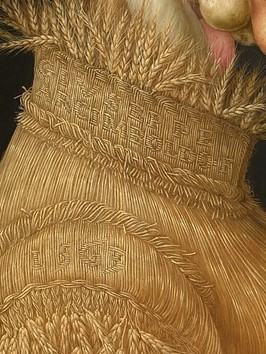
The Four Seasons – Summer (detail of signature), 1563, oil on panel, 670×508 mm, Kunsthistorisches Museum, Vienna, Austria
https://commons.wikimedia.org/wiki/File:Giuseppe_Arcimboldo_-_Summer_-_Google_Art_Project.jpg
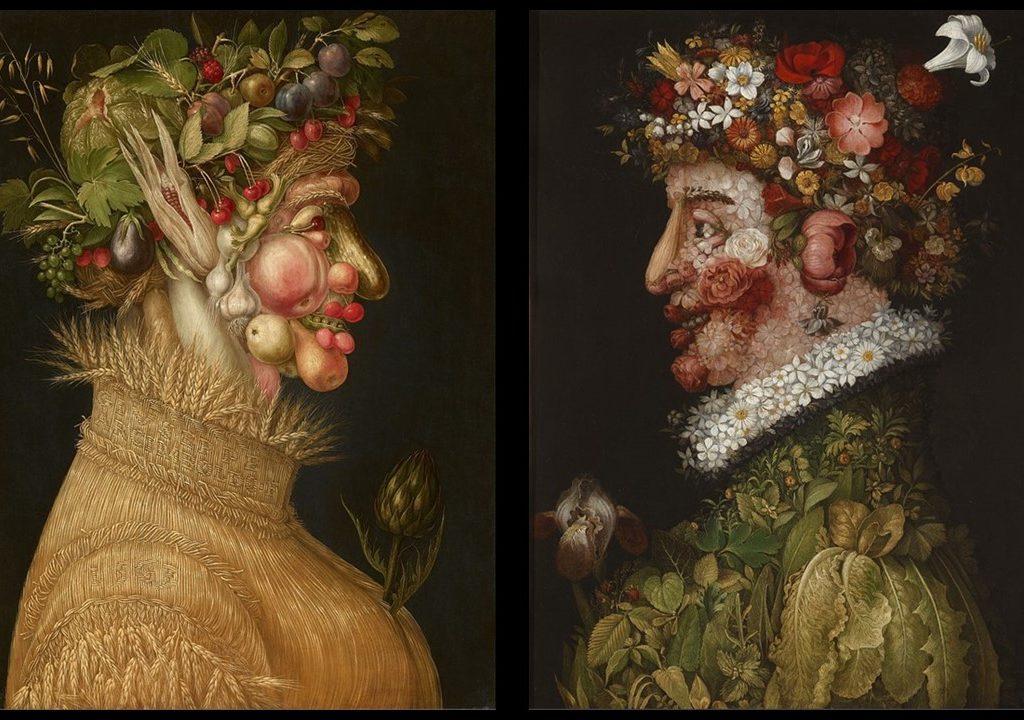
The Four Seasons – Summer, 1563, oil on panel, 670×508 mm, Kunsthistorisches Museum, Vienna, Austria
https://commons.wikimedia.org/wiki/File:Giuseppe_Arcimboldo_-_Summer_-_Google_Art_Project.jpg The Four Seasons – Spring, 1563, oil on canvas, 76×63.5 cm, Real Academia de Bellas Artes de San Fernando, Madrid, Spain
https://commons.wikimedia.org/wiki/File:Giuseppe_Arcimboldo_-_La_Primavera_-_Google_Art_Project.jpg
A comparison between Arcimboldo’s Portraits of Spring and Summer is helpful and revealing. Spring is presented as a youthful, flowery, “fresh” girl, while Summer, is a young woman, mature and fertile. The Portrait of Spring is composed entirely of flowers and bright green leaves. The Portrait of Summer is a lush arrangement of heavy, ripe fruit and vegetables, bountiful, unblemished, but matured. Arcimboldo uses a large peach for the cheeks, quince, garlic, young white onions, yellow beets, and white eggplant. The mouth and lips are formed of cherries and the open peapod within imitates a row of teeth. The nose is a young wild cucumber, and the chin is a pear, the eye shines as a glassy sour cherry between two small pears… What an arrangement! My favorite part is what Lady-Summer wears… a hat made of fruit and vegetables bedded in greenery, from which emerge oat spikes resembling a hat feather, a magnificent, sur mesure, woven straw jacket, and a single artichoke presented as a special, luxurious piece of jewelry! What an opulent vision the Portrait of Summer is! https://www.teachercurator.com/art/spring-by-giuseppe-arcimboldo/ and https://www.wga.hu/html_m/a/arcimbol/3allegor/1seaso2.html and http://omeka.wustl.edu/omeka/exhibits/show/arcimboldo-s-gift–the-fantast/fourseasons/summer
For a PowerPoint of the Four Seasons by Giuseppe Arcimboldo, please… Check HERE!
I would like to draw your attention to a modern take of Arcimboldo’s The 4 Seasons paintings… a set of four and a half meters high fiberglass sculptures of the Four Seasons by American artist and filmmaker Philip Haas, created in 2012. Interesting… to say the least! https://crystalbridges.org/blog/the-four-seasons-philip-haas-interprets-giuseppe-arcimboldo/
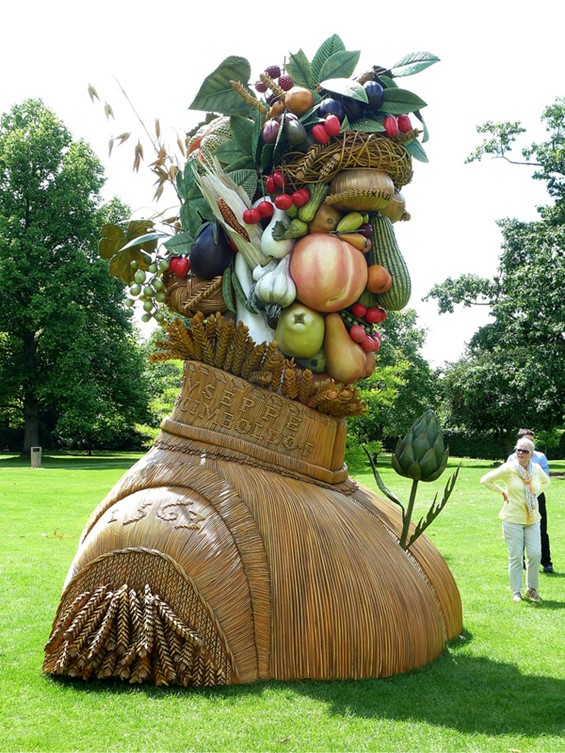
The Four Seasons – Summer, 2012, fiberglass, H. 4.572 m, first seen in the garden of the Dulwich Picture Gallery, London, UK
https://laughingsquid.com/giant-head-sculptures-representing-four-seasons/